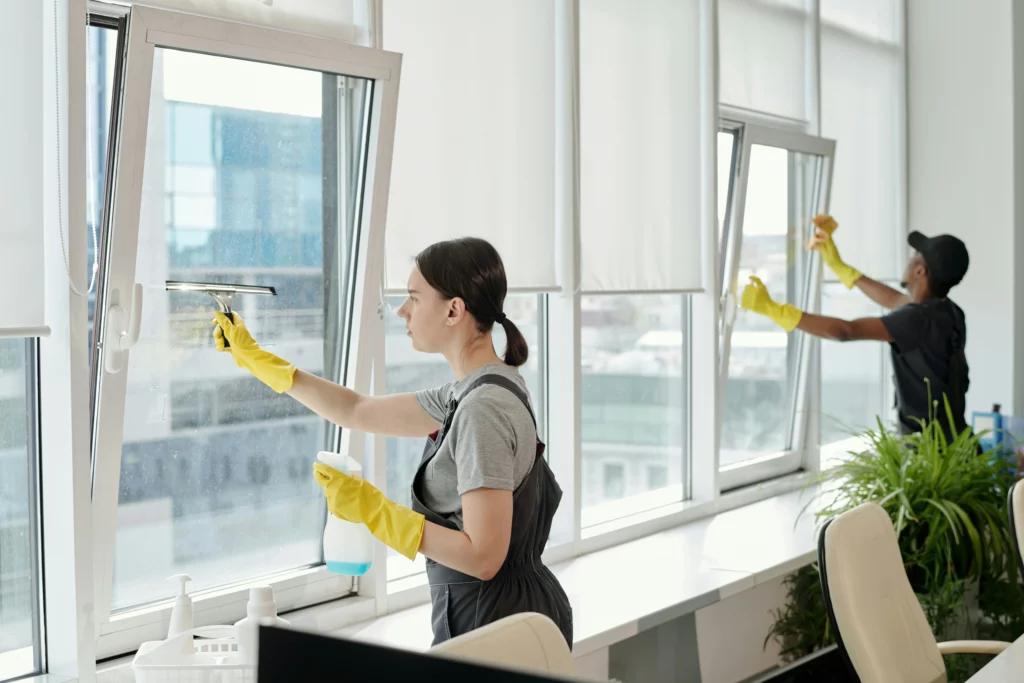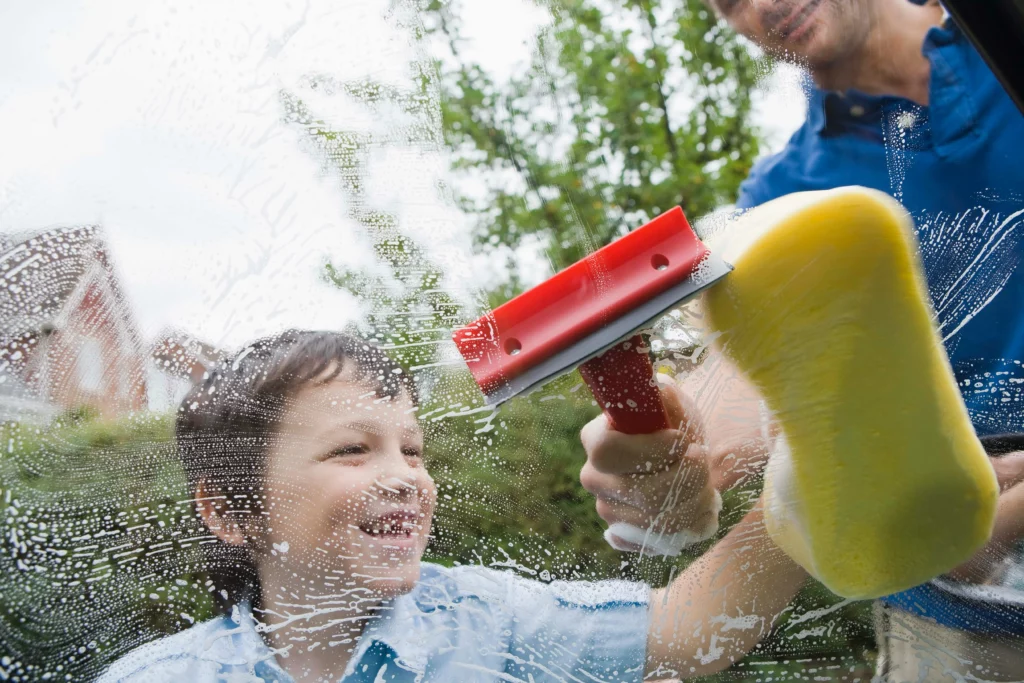Welcome to Geek Window Cleaning’s comprehensive guide on achieving streak-free windows using a squeegee. Clean windows enhance the beauty of your home or business, letting in natural light and providing clear views. In this guide, we’ll cover everything you need to know about window cleaning with a squeegee, from the tools you need to the best techniques for a flawless finish.
Why Choose a Squeegee for Window Cleaning?
Window cleaning with a squeegee is one of the most efficient and effective methods for maintaining crystal-clear windows. But why is a squeegee the preferred tool for professionals and homeowners alike?
The Wrong Tools for Window Cleaning
Many people resort to using common household items for window cleaning, but these can often lead to unsatisfactory results. Here’s why some common tools fall short:
Paper Towels
Paper towels are widely used for cleaning windows, but they tend to leave lint and streaks behind. Additionally, paper towels can be wasteful and costly over time. They also do not provide the smooth, continuous swipe that a squeegee can, often leaving windows looking patchy.
Cloths
While cloths can be reusable and cost-effective, they often smear dirt around rather than removing it. This smearing can lead to streaks and residues on the glass. Additionally, cloths can become saturated with dirt and cleaning solution, reducing their effectiveness as you clean.
Newspaper
Using newspaper is an old trick that some people swear by, but it can be messy and leave ink stains on your hands. The rough texture of newspaper can also leave behind tiny scratches on your glass over time, and it doesn’t provide the efficiency and streak-free finish that a squeegee can offer.
Essential Tools and Materials
To achieve professional results with your window cleaning, you’ll need the following tools and materials:
- High-Quality Squeegee: Ensure your squeegee has a sharp, flexible rubber blade. A 10-12 inch squeegee is ideal for most residential windows, while larger squeegees are suitable for commercial windows.
- Bucket: Fill it with a mixture of water and a few drops of dish soap. Avoid using too much soap, as it can leave residue on the glass.
- Scrubber or Sponge: For applying soapy water to the windows. A scrubber with a handle is preferable for better reach and control. A natural sponge can also be a valuable tool for advanced window cleaning. It helps wipe the squeegee, clean the edges of the glass, and pick up excess water. Using a sponge minimizes the need for detailed cleaning and helps achieve a streak-free finish.
- Microfiber Cloths: To wipe edges and clean up any drips. Microfiber cloths are lint-free and absorbent, making them perfect for finishing touches.
- Extension Pole: For reaching high windows. An adjustable pole can help you clean second-story windows without a ladder.
- Stable Ladder: For safe access to higher areas. Ensure the ladder is on a stable, flat surface and never overreach.
Preparing Your Windows for Cleaning
Proper preparation is essential for effective window cleaning. Here are the steps to prepare your windows:
- Remove Dust and Loose Dirt: Use a dry cloth or duster to remove any loose debris from the window surface and frame. This prevents dirt from turning into mud when you apply the soapy water.
- Check for Stubborn Stains: Identify any tough spots that may require extra scrubbing, such as bird droppings or sap. Use a gentle abrasive pad or a specialized window cleaner for these areas.
Step-by-Step Guide to Using a Squeegee
Follow these steps for streak-free window cleaning with a squeegee:
- Apply Soapy Water: Dip your scrubber or sponge into the bucket of soapy water. Wring out excess water to prevent dripping. Apply the soapy water evenly across the window, making sure to cover all areas. For stubborn spots or grime, use a bit more pressure or a gentle scrubbing motion.
- Start Squeegeeing: Begin at the top corner of the window. Place the squeegee at a slight angle and pull it down in a straight line, maintaining consistent pressure. Wipe the blade with a microfiber cloth after each pass to prevent streaks.
- Overlap Strokes: Move the squeegee back to the top, slightly overlapping the previous stroke, and pull down again. Continue this process until you reach the bottom of the window. Overlapping ensures no water or soap residue is left behind.
- Wipe Edges and Corners: Use a microfiber cloth to wipe any remaining water from the edges and corners of the window. This ensures no drips or water spots are left behind, leaving the window completely clean.
The Professional Squeegee Technique
To achieve the best results, perfect your squeegee technique:
- Angle and Pressure: Hold the squeegee at a slight angle, about 30 degrees, to the glass and apply even pressure. This angle helps direct the water downwards, minimizing streaks.
- Consistent Strokes: Use consistent, smooth strokes to avoid streaks. Start at the top and work your way down, ensuring each stroke overlaps the previous one slightly.
- Edge Work: Pay special attention to the edges and corners of the window, as these areas are prone to streaks. Use the tip of the squeegee or a microfiber cloth to clean these areas thoroughly.
The Most Common Window Cleaning with a Squeegee Mistakes to Avoid
Even with the right tools, certain mistakes can lead to less-than-perfect results. Here are common pitfalls to watch out for:
Using Too Much Soap
Excess soap can leave a residue on the glass, making it appear hazy. A few drops of dish soap in a bucket of water are sufficient for cleaning windows. Too much soap creates excess suds that are difficult to remove completely.
Applying Too Much Pressure
Gentle, even pressure is key. Pressing too hard can damage the rubber blade and scratch the glass. It can also cause the squeegee to skip or drag, resulting in streaks.
Neglecting the Edges
Always wipe down the edges and corners to prevent streaks and water spots. These areas often hold excess water that can drip and leave marks after you’ve finished cleaning the main surface.
Using a Too Wet Squeegee
Ensure your squeegee blade is not too wet, as excess water can lead to streaks. Wipe the blade with a microfiber cloth after each pass to remove any accumulated water and dirt.
Tips for Maintaining Your Squeegee
Proper maintenance of your squeegee is crucial for achieving streak-free windows:
- Clean the Blade: Rinse the blade after each use to remove any dirt or debris. This prevents the blade from scratching the glass and ensures smooth, streak-free swipes.
- Replace When Necessary: Replace the rubber blade when it becomes worn or nicked. A damaged blade can cause streaks and scratches on the glass.
- Store Properly: Store your squeegee in a dry, cool place to prolong its lifespan. Avoid leaving it in direct sunlight or extreme temperatures, as this can damage the rubber.
Cleaning High and Hard-to-Reach Windows
For high or hard-to-reach windows, use an extension pole and ensure you have a stable ladder. Safety is paramount, so take the necessary precautions:
- Use an Extension Pole: An adjustable extension pole allows you to clean high windows without a ladder. Attach your squeegee and scrubber to the pole for easy access.
- Stable Ladder: If you need to use a ladder, ensure it is on a stable, flat surface. Never overreach—move the ladder as needed to maintain balance.
- Buddy System: For added safety, have someone hold the ladder for you while you clean high windows.
Frequently Asked Questions
Where Can I Buy a Squeegee?
Squeegees can be purchased at hardware stores, home improvement centers, and online retailers. Look for high-quality squeegees with replaceable rubber blades for the best results.
Can a Squeegee Scratch Glass?
A squeegee itself won’t scratch glass, but a damaged or dirty blade can. Always ensure the blade is clean and in good condition before use to prevent scratches.
Can You Use a Squeegee with Windex?
Yes, you can use a squeegee with Windex, but soapy water is often more effective for achieving a streak-free finish. Windex can dry quickly, potentially leaving streaks if not wiped immediately.
Conclusion: Enjoy Your Streak-Free Windows
Window cleaning with a squeegee is a tried-and-true method for achieving spotless, streak-free windows. With the right tools, techniques, and a bit of practice, you can enjoy the clear views and enhanced aesthetics of perfectly clean windows. At Geek Window Cleaning, we are dedicated to helping you maintain the beauty and value of your property. For the best window cleaning in Houston and more professional cleaning tips and services, contact us today!
After achieving streak-free glass with a squeegee, consider these tips to effectively Clean Window Screens for a polished finish.



Recent Comments